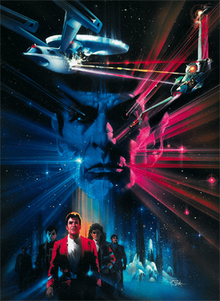
Back Star Trek III: The Search for Spock AN ستار تريك 3: البحث عن سبوك Arabic Зорны шлях: У пошуках Спока BE-X-OLD Стар Трек III: В търсене на Спок Bulgarian Star Trek 3: A la recerca de Spock Catalan Star Trek III: Pátrání po Spockovi Czech Star Trek III: The Search for Spock Welsh Star Trek III - Jagten på Spock Danish Star Trek III: Auf der Suche nach Mr. Spock German Σταρ Τρεκ Νο 3: Αναζητώντας τον Σποκ Greek
| Star Trek III: The Search for Spock | |
|---|---|
 Theatrical release poster art by Bob Peak | |
| Directed by | Leonard Nimoy |
| Written by | Harve Bennett |
| Based on | Star Trek by Gene Roddenberry |
| Produced by | Harve Bennett |
| Starring | |
| Cinematography | Charles Correll |
| Edited by | Robert F. Shugrue |
| Music by | James Horner |
Production company | |
| Distributed by | Paramount Pictures |
Release date |
|
Running time | 105 minutes[1] |
| Country | United States |
| Language | English |
| Budget | $16 million[2] |
| Box office | $87 million[3] |
Star Trek III: The Search for Spock is a 1984 American science fiction film, written and produced by Harve Bennett, directed by Leonard Nimoy, and based on the television series Star Trek. It is the third film in the Star Trek franchise and is the second part of a three-film story arc that begins with Star Trek II: The Wrath of Khan (1982) and concludes with Star Trek IV: The Voyage Home (1986). After the death of Spock (Nimoy), the crew of the USS Enterprise return to Earth. When James T. Kirk (William Shatner) learns that Spock's spirit, or katra, is held in the mind of Dr. Leonard "Bones" McCoy (DeForest Kelley), Kirk and company steal the decommissioned USS Enterprise to return Spock's body to his homeworld. The crew must also contend with hostile Klingons, led by Kruge (Christopher Lloyd), who are bent on stealing the secrets of the powerful terraforming device, Genesis.
Paramount Pictures commissioned the film after the positive critical and commercial reaction to The Wrath of Khan. Nimoy directed this film, becoming the first Star Trek cast member to do so. Producer Harve Bennett wrote the script, starting from the end and working back, and intended the destruction of the Enterprise to be a shocking development.
Bennett and Nimoy collaborated with effects house Industrial Light & Magic to develop storyboards and new ship designs; ILM also handled the film's many special effects sequences. Aside from a single day of location shooting, the film was shot entirely on Paramount and ILM soundstages. Composer James Horner returned to expand his themes from the previous film.
The Search for Spock opened on June 1, 1984. In its first week of release, the film grossed over $16 million from almost 2,000 theaters across North America. It went on to gross $76 million at the domestic box office, with a total of $87 million worldwide. Critical reaction to The Search for Spock was generally positive, but notably less so than the previous film. Reviewers generally praised the cast, Nimoy's direction, and characters, while criticism tended to focus on the plot; the special effects were conflictingly received. Roger Ebert called the film a compromise between the tones of the first and second Star Trek films.
- ^ "STAR TREK III - THE SEARCH FOR SPOCK (PG)". British Board of Film Classification. May 18, 1984. Archived from the original on January 28, 2015. Retrieved May 22, 2013.
- ^ Fisher, Bob (April 1984). "Director Leonard Nimoy focuses on 'Star Trek III: The Search for Spock". On Location: The Film and Videotape Production Magazine. 7 (12): 34.
- ^ Eller, Claudia (1998-12-11). "Lower Costs Energize 'Trek' Film Profits". Los Angeles Times. Archived from the original on 2020-11-18. Retrieved 2020-05-21.
© MMXXIII Rich X Search. We shall prevail. All rights reserved. Rich X Search